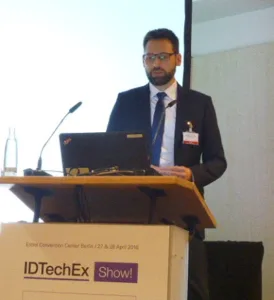Arne Fleissner is a development engineer at Osram, and spoke about OLED lighting. Controversially, he began his discussion with the question, “Do we even need OLED any more?” OLED’s traditional advantages of large area and homogeneity can be accomplished with an LED light source and a diffuser, he argued. However, OLED still has advantages in its thinness, flat form factor and low power.
Fleissner believes that OLED’s first volume lighting application will not be in the price-sensitive general illumination market, but in automotive lighting, which puts a high value on design and reliability. However, the robustness criteria (high and low temperatuture operation, etc) are high and may prove challenging to overcome. Osram, however, has achieved the entry-level requirements defined by the EU, for exterior OLEDs on rigid glass. Production will begin this year.
The most-requested feature for OLEDs in automotive applications was named as flexibility, which Osram has not managed yet. Car makers want this as a design feature.
Another challenge for automotive OLEDs is the ability to keep colour within the ECE ‘Red Corridor’ (the band of red colour that car lights must fall into). This was examined and optimised in the R2D2 project, which closed in 2015 (Fraunhofer Investigates Flexible Lighting). Audi, for example, had to test the OLED tail lights used in the TT RS from all angles – and Fleissner was happy to report that they passed every test.
OLED lifetime is not an issue over the expected lifetime of a car, said Fleissner, but robustness and reliability are. These challenges are still to be solved.

